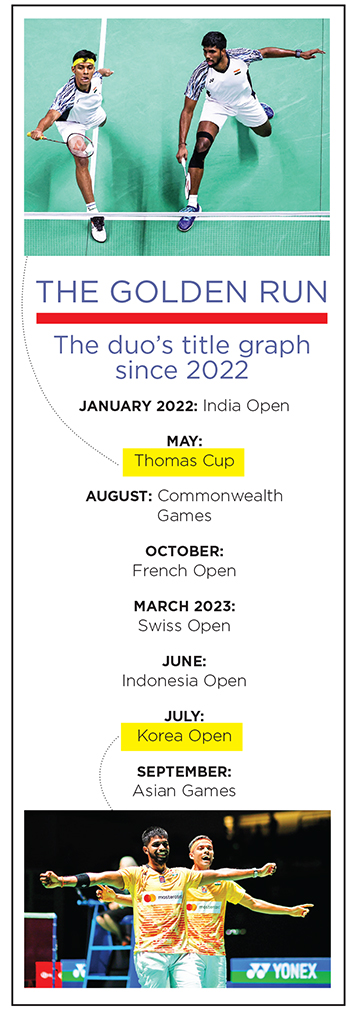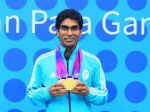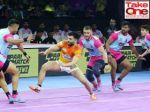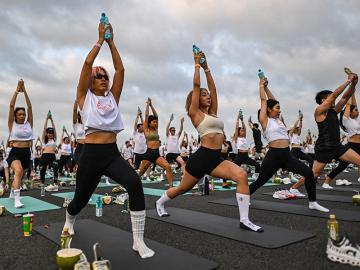
Chirag Shetty and Satwiksairaj Rankireddy: From reluctant partners to being world no. 1
Shetty and Rankireddy have achieved a series of firsts for Indian badminton, including a stint at being world no. 1
 Chirag Shetty (left) and Satwiksairaj Rankireddy at the Pullela Gopichand Badminton Academy in Hyderabad. Photography: Vikas Chandra Pureti for Forbes India; Styling: Rekha Boggarrapu & Team Niharika Varma; Makeup: Sahara
Chirag Shetty (left) and Satwiksairaj Rankireddy at the Pullela Gopichand Badminton Academy in Hyderabad. Photography: Vikas Chandra Pureti for Forbes India; Styling: Rekha Boggarrapu & Team Niharika Varma; Makeup: Sahara
In some other universe, this could very well have been two impish kids trying to disrupt the class from the backbench. But this, to quote a cliche, is Sat-Chi’s universe and we are just living in it, soaking in a moment of comic relief as perfectly timed as their smashes.
From being one of the most reluctant pairs when they started, Shetty and Rankireddy now are among the world’s most formidable, having bagged a string of firsts over the last year and a half for a country that hasn’t had much of a history in doubles to write home about despite producing stellar singles players over decades. The duo began 2022 by winning the India Open and played a crucial role in India’s historic maiden victory at the Thomas Cup. They followed it up by being the first Indian doubles pair to win the Commonwealth Games gold, the first to medal at the World Championships, and, again, the first to win a Super 750 event, at the French Open.
But 2022 wasn’t just a flash in the pan. It was the start of a smouldering streak that continued with the victory at the Asian Championships in Dubai in 2023, winning India’s first-ever doubles gold medal in the Asian Games, becoming the first doubles pair to win a marquee Super 1000 tournament (at the Indonesia Open), and, also, emerging victorious at the Korea and Swiss Opens. The duo was also briefly ranked World No. 1 after the Asian Games victory, before they slid to No. 5 following an early exit from the French Open.
Shetty and Rankireddy wrapped up the year as World No. 2 (as of December 5) after their runners-up finish in the China Open pushed them up a few spots—the loss in the final was their only one in the last nine title clashes. And despite failing to make the cut for the BWF World Finals—as they lost points after facing injury setbacks early in the year, and also since points for Asian Games and the Asian championships don’t count for this event—there’s no denying that their achievements through the past 24 months have been nothing short of staggering. And to think that, in the beginning, both Shetty and Rankireddy had their own partners and weren’t keen on playing with each other. Also read: Satwiksairaj Rankireddy and Chirag Shetty: A smashing duo rewriting badminton history
Shetty, who hailed from a family of hoteliers in Mumbai, started playing recreationally at Mumbai’s Goregaon Sports Club, while Rankireddy came from a family of sports enthusiasts, especially his father, in Andhra’s Amalapuram. It was following his former doubles partner Krishna Prasad Garaga (now ranked World No. 45 along with Vishnuvardhan Goud Panjala) that Rankireddy joined the Gopichand Academy in Hyderabad around 2012, while Shetty came after a few years, as part of a national camp taking place in the academy. “Our first national doubles coach, Tan Kim Her, who came from Malaysia in 2015, paired us together,” says Rankireddy. “He thought both of us were tall, and were more strongly built than other Indian players, so that would help us play at the highest level.”
While that worked in theory, to build an understanding of each other, key to a successful doubles partnership, was easier said than done. Shetty and Rankireddy were as apart as chalk and cheese, beginning with the language they spoke. “Hindi or English doesn’t come naturally to me. Instinctively, I speak in Telugu,” says Rankireddy. “With Chirag, who came from Mumbai, I would have to think twice before I could speak. So, initially, I wouldn’t speak to him during matches.”
One of their coaches suggested they spend time together off the court, and have at least one meal a day together. The opportunity came when they were travelling abroad, and both would head out on a search for a cuisine they both loved: Indian.
That their eating out routine turned out to be a huge success isn’t just evident from the fact that Shetty can now understand Telugu well, but also, says Rankireddy, that they now have a telepathic connection. “Even if I don’t talk to him on court now, I know where Chirag’s playing and what shot he will play, and he knows the same about me.”
The only thing they probably don’t agree on is who’d win a singles match between them. “Me,” both raise their hands, giggling.
The build-up
For Shetty, the turning point in their career, the one that gave them confidence that they were good for the elite level, came during the Korea Open in 2017, when they made their first Super Series quarterfinal beating seventh seeds Lee Jhe-Huei and Lee Yang of Chinese Taipei in the second round. “When we beat the Top 10 pair, it made us feel that we were fit for that level,” says Shetty. “To add to it, next year, at the Indonesia Masters, we made our first Super Series semi-final.” There’s been no looking back since, as the titles started pouring in, with the silver in the 2018 Commonwealth Games in Australia’s Gold Coast, and victory at the Hyderabad Open Super 100 later that year. One of the great things about the rise and rise of Shetty and Rankireddy, says Aparna Popat, Olympian and nine-time national singles champion, is the way they’ve built themselves up over the years. “They’ve first won smaller tournaments—from the Super 100s, to the 500s, to the 750 last year and this year the Super 1000,” she says. “Their progression shows how they’ve worked their way up systematically. Such players tend to sustain their performance over the long term.”
One of the great things about the rise and rise of Shetty and Rankireddy, says Aparna Popat, Olympian and nine-time national singles champion, is the way they’ve built themselves up over the years. “They’ve first won smaller tournaments—from the Super 100s, to the 500s, to the 750 last year and this year the Super 1000,” she says. “Their progression shows how they’ve worked their way up systematically. Such players tend to sustain their performance over the long term.”Along with building their portfolio of silverware step-by-step, Shetty and Rankireddy have also turned out to be big-match aces, closing out tough games. “I noticed this at the 2021 World Championships in Japan, where I was commentating,” says Popat. “You could sense that even if the matches were close, they had the belief they could get across the finish line. That helps them in winning matches from precarious positions like 18-19 or 19-20. It shows they’ve gained in patience and confidence to stay steady at the closing stages of the games.”
Consider the semi-final of the 2023 Indonesia Open where Shetty and Rankireddy lost the first game against World No 6 Kang Min Hyuk and Seo Seung Jae, only to bounce back and win the next two in a closely-fought 21-19, 21-18. In the next match, the final, they faced indomitable Malaysians Aaron Chia and Soh Wooi Yik who had won their previous eight head-to-heads. “If someone says it wasn’t playing in our minds, they would be lying,” says Shetty. “But the key is to not panic, to understand that your opponent is equally under pressure. So, if you are even 10-15 percent calmer than your opponent, you will come out on top.”
Or, the Asian Games, where Shetty was down with a viral infection in the middle of the tournament, and walked into the pre-quarterfinals thinking they had nothing to lose since they weren’t in the best shape. “Let’s just play our 100 percent on the day and not think about the result, we thought. And we ended up winning,” says Shetty. “You see, the more you think about winning, the more pressure you put yourself under.”
Essentially, says Rankireddy, over the last few years, the duo has learnt not to let the opponent live in their heads rent-free. “What’s the worst that could have happened in the Indonesian Open? We would have lost to Chia and Yik one more time, making our head-to-head 9-0. So we didn’t think about one more loss and, instead, decided not to let them dictate us,” he says. “Previously, if they played one good shot, we gave them so much respect that they would win a few more points from there on. This time, we played our own game.”
Keep calm and carry on
Pullela Gopichand, former All-England champion and an iconic badminton coach, has groomed both Shetty and Rankireddy for nearly a decade now. “Even with the naked eye,” says Gopichand, “one notices how hard they hit. Their attack is the best in the world, and mentally, too, they have matured well.” The evidence of the duo’s power lies in the 565 km/hr smash that Rankireddy hit during this year’s Korea Open, eclipsing a decade-old record—to put that in perspective, an F1 car attains a top speed of 345 km/hr.Also read: Pullela Gopichand: No backup plan for many players, need to secure them through sponsorships and jobsAsked to choose between their recent list of victories, Shetty and Rankireddy pick the Thomas Cup as their favourite, not just because it was India’s first ever, but because they were playing as a team with shuttlers like Lakshya Sen, K Srikanth and HS Prannoy. “This was Chirag’s equivalent of the cricket World Cup,” laughs Rankireddy, alluding to his partner’s love for cricket growing up, something he had to give up once his father introduced him to badminton.
As their coach, though, Gopichand wouldn’t like to pinpoint which of their achievements has satisfied him the most. What makes him the happiest is the will to win with which they approach every match. “They’re young, they’re very good, and they will win every possible tournament in the world multiple times. They might win an Olympic medal next year, or, even if they don’t, they’re going to win it the next time or the next. The important thing is to play matches, win or lose, and get back the next day and start training,” he says.
It was early in his career that Gopichand pushed Rankireddy into doubles. While his physicality was a deciding factor, the chief national coach also applauds his game awareness. “He sees the game in slow motion—it’s as if he can see an opponent frame by frame,” says Gopichand. “Chirag, on the other hand, has a fantastic on-court speed and he’s improved tremendously in hitting, not just smashing. The speed he can generate out of his racquet on his blocks, on drives with very little follow through or backlift, I think it’s fantastic.”

Shetty has an aggressive, intense personality on the court, which Gopichand is often instrumental in toning down. “During the Asian Games final, Gopi Sir was constantly asking us to breathe in and breathe out—he knew how charged up we were—so we eased down a bit. He has been a calming presence from the coaching chair, and that really helped us in the Asiad and even the Indonesian Open,” says Shetty.
Training with Gopichand at his academy in Hyderabad and rubbing shoulders with the likes of singles champions Saina Nehwal and PV Sindhu, who trained here earlier, or current trainees like former World No. 1 Srikanth and Prannoy, now World No. 12, have also opened avenues of learnings for Shetty and Rankireddy—not just in terms of skills on the court, but also off it. Rankireddy recalls how pressure sat on him like a brick on the eve of the final match of the Commonwealth Games in 2018. “I asked Srikanth bhaiya how he handles it, since he’s been World No. 1 and would have faced the pressure every time he stepped on the court. He told me to focus only on things that I can control, which is my game,” he says. “It’s something I think about before every big match even now—that my job is to play, baaki jo hoga baad mein dekha jayega [whatever happens, we’ll deal with later].”
To stay calm is a lesson that the duo has also picked up from Mathias Boe, Danish doubles player, Olympic medallist and former World No. 1. Boe joined as the national doubles coach in early 2021, and his tenure has coincided with the rise of Shetty and Rankireddy over the past two years. With Boe, the duo has learnt to stick to a plan. “Nothing that we do on court is random,” says Rankireddy. “We have a meeting before a match, formulate a plan and stick to it, come what may.” Shetty and Rankireddy had caught Boe’s eye even in the final years of his own career—the Dane recalls losing his last match against them in the Syed Modi International in 2018. Back then, Shetty’s forte used to be the front of the court, while Rankireddy played mid- and back of the court. “Lately, Chirag has developed his back-court game, while Satwik his net game. They can now play in reverse positions,” says Boe. “It makes them a diverse pairing, and it’s one of the reasons why they’ve won many big events recently.” Their all-round skills mean that if one isn’t smashing well one day, says Boe, the other can take over and cover for him.
Their bounty of wins has also given them the confidence to go shoulder-to-shoulder with top pairs. “They might have lost to Chia and Yik eight times in a row, but I’ve told Chirag and Satwik that while the Malaysians might be a bit more consistent than them, they certainly aren’t better,” says Boe. “So, while it’s okay to be behind 5-7, there is no reason why they should be behind 0-8. They hadn’t had that confidence earlier, and they were losing a bit too easily, and that’s what is making a big difference now.”
Stars and stripes
Their purple patch over the last year and a half has also brought Shetty and Rankireddy a windfall in terms of endorsements, amping up their brand equity. Six brands have roped in the duo in the last six months and, according to market estimates, they are said to have signed deals worth nearly Rs 7 crore during this period. Their endorsement fees have also risen around 30 to 40 percent.Says Tuhin Mishra, co-founder and managing director of Baseline Ventures that represents the pair: “Chirag and Satwik represent what today’s India is—where they don’t care about where they come from or what their background is; they just make their way to the top being good at what they are. And this is how we are positioning them—how they’ve risen to the top from their humble beginnings purely on merit.” Also read: Is Badminton still a hard sell in India?
Sourabh Lohtia, marketing head, PNB MetLife, which has signed them up as mentors for the PNB MetLife Junior Badminton Championship, underlines Shetty and Rankireddy’s inspiring journey to overcome challenges as one of the key reasons behind the brand signing them up. “Their journey from aspiring shuttlers to World No. 1 men’s doubles team and becoming the first ever Indian doubles pair to win the Asian Games gold showcases not only their sporting prowess but also their ability to overcome challenges. By having them as mentors, we aim to showcase real-life examples of dedication, perseverance and sportsmanship to young talents.”
Baseline’s Mishra recalls that, around 2016, Shetty had wanted to join the programme, but missed the trials since he was travelling. “Life has indeed come full circle for him now,” he says.
Are Shetty and Rankireddy conscious of their new-found star status? Gopichand doesn’t think so. “They are sorted in their head, very respectful, courteous, down-to-earth—unlike some players who win a title and are all over the place,” he says.
The World No. 1 rank might have had them wide-eyed for a bit, says Boe, but that’s not unusual, he adds.

“Even I had a pinch-me moment when I became No. 1 for the first time. The trick for an athlete is to put a check mark against an achievement and search for the next goal. They struggled a bit with that perhaps, and lost in the French Open early after attaining the No. 1 rank. But I am sure they will become better at this in future,” says Boe.
Shetty and Rankireddy are aware of the responsibilities that their upward climb has brought them, especially with an Olympic Games seven months away. The qualification pathway that began on May 1 and will conclude on April 28, 2024, will select 16 men’s doubles pairs based on the results during this period. The last Olympics ended in a heartbreak for the boys as they failed to qualify for the knockouts on a technicality despite winning two matches out of three in the group, and beating eventual champions Chi-Lin Wang and Yang Lee of the Chinese Taipei. This year, Shetty and Rankireddy are starting off with short-term targets: Of winning big events like the Malaysian Open in January and the All-England Open in March. “But the Olympics are always at the back of our minds—it’s the major goal for us,” says Shetty.
What both Gopichand and Boe have taught them is to be professional with badminton—not just training well, but investing in the sport even outside of training. Sleep well, eat well, be on time, for instance. “I wish I could tell you how hard it is to do these simple things well, especially to sleep well in the age of social media,” laughs Rankireddy.
Shetty says he’s willing to risk everything to hear the umpire announce the score in their favour. “All those missed Diwalis are worth it when the final shuttle lands and you reach 21 points,” he says. “I will give it my all just to hear the umpire say that.”
Post Your Comment


















